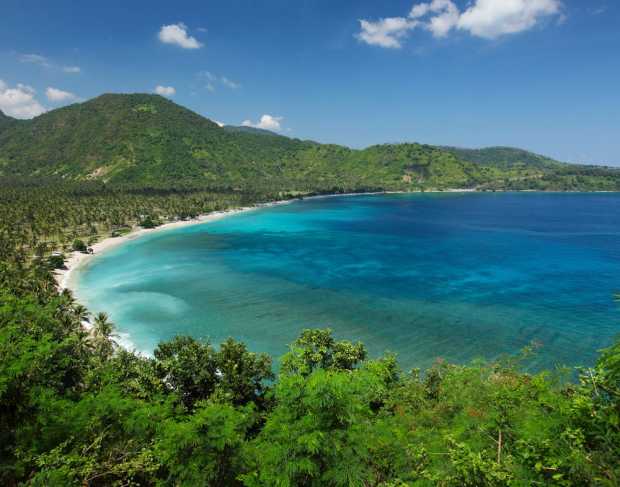Not a member yet? Sign Up!
Info
Please use real email address to activate your registration

“Lombok’s tourism depends on Bali,” says our driver who is taking us to Malimbu Cliff to see the sunset along the Senggigi strip in Lombok.
Some may not agree with him, but the island of Lombok in Nusa Tenggara Province is receiving tourists overflow from Bali. International media outlets such as Time, The Guardian, and Conde Nast Traveller have been promoting Lombok as an alternative to Bali or a destination after Bali.

Lombok, about 30 minutes flight time from Bali, has the views, the high end accommodations, the restaurants and the sandy beaches that Bali have with less crowd compared to its world famous neighboring island.
Endless scenic views
Senggigi with 10km of coastal road is Lombok's oldest and most famous resort area. It has a series of white sandy beaches and safe swimming areas with good waves for surfers and colorful reefs for snorkeling.
Mount Rinjani, two hours away, is the second highest mountain in Indonesia. Pristine forests on its slope adorned with waterfalls and magnificent sceneries is well known as the place where the tropical flora and fauna of South East Asia meets that of Australasia.

We arrived at Malimbu Cliff in Senggigi just in time for a beautiful sunset with Bali’s Mount Agung in view. The famous small islands Gili Meno, Gili Trawangan and Gili Air help set the natural scene.
Food huts sell soft drinks, cup noodles, grilled fish, jagung bakar (warm roasted corn), and kelapa muda (young coconut juice with coconut slices) for those who are enjoying the sunset.
Along with many international visitors, we settled with jagung bakar and kelapa muda, found a bench, breathing in the sea breeze, and never took our eyes from the sun setting on the horizon.
Spicy and healthy food
Lombok is famous for its culinary spread, the most popular of which is Ayam Taliwang. An old article at The Jakarta Post described how Taliwang chicken is prepared. The meat is grilled until it is half done, tenderized with a pounder and dipped into hot cooking oil for several seconds. It is then immersed into spicy sauce, a combination of chili, garlic and terasi (shrimp paste) before it is grilled or fried to well done.
Ayam Taliwang is usually accompanied by crunchy plecing kangkung, a vegetable dish with boiled water spinach, bean sprout, grated coconut and chili.
There are many more Lombok traditional dishes such as bebalung (short ribs soup), sate bulayak (satay cooked with coconut milk and rice cakes on the side) and ebatan (mixed vegetables with hot spices and grated coconut).
At dinner in Mataram, the provincial capital, we sit overlooking a paddy field in Warung Dakota and savored Package 6, consisting of boiling fish soup in a pot, grilled fish and lobster, squid, chicken and sate rembiga, a spicy and hot beef satay.
A cup of serbat neutralized all the savory tastes, as this Javanese traditional warm drink is a mixture of boiled water with brown sugar, fresh cinnamon, clove, nutmeg, ginger, lemon grass and other spices.
Traditional woven fabric
Lombok is also famous for its arts and crafts. Lombok pottery is a hand-coiled, pit-fired earthenware pottery in a tradition handed down for generations. We have these fragile potteries in our home that look timeless for any home decoration.

Near Lombok International Airport there is a village often visited by international visitors. Sukarara village is where Sasak tribe women weave traditional fabric. They begin to weave at 10 years of age. When each marries the man of her dream she is supposed to have one sarong personally weaved.
We dropped by the simple houses at Sukarara where each house has traditional weaving equipment on the porch. The ladies like working outside for the light and the fresh air.
Nearby, at Patuh Cooperative, guests can choose traditional fabric that they fancy with reasonable price. Guests can also try how to weave, guided by the ladies there.
An island with a legend
Lombok in a Day is the goal of some visitors, but one day is just not enough to see many more attractions and to learn about the legend of Princess Mandalika, a princess who threw herself into the sea to avoid blood shed among her suitors and returns annually as colorful seaworms.
Browse the Indonesia’s Official Tourism Website for initial information on culinary, historical, sports, and sustainable marine tourism on the island of Lombok.
-----------------------------------
Images: Dudarev Mikhail/ Shutterstock, M. Ridwan Soleh, Murni Titi Resdiana, Wikitravel, Omar Niode Foundation